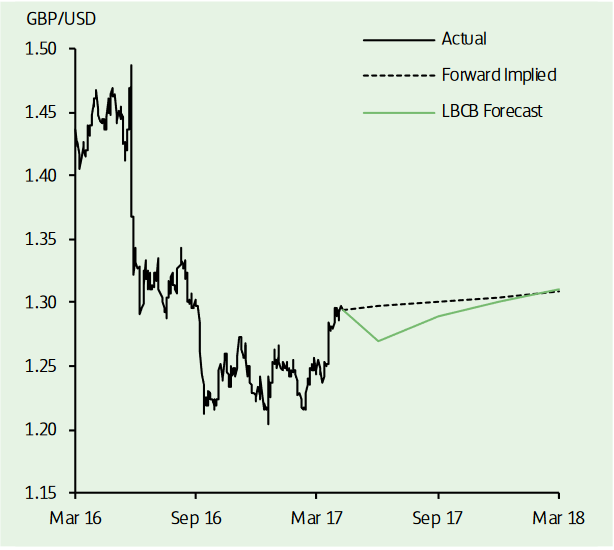The GBP/USD Rate May Struggle Above 1.30 Psychological Barrier

The British Pound may find it difficult to hold onto gains above the 1.30 psychological level against the US Dollar according to Lloyds Bank Commercial Banking who issued their revised forecasts in a recent note to clients.
They expect GBP/USD to end 2017 at 1.3000 – not far above where it is now at 1.2941.
The call comes as Sterling is seen making another attempt on this seemingly magical number.
"Sterling bid up heavily on the open today as traders eye a potential assault on the psychologically important $1.30 handle, which if breached could yield a fresh leg higher for the pound," said analyst Neil Wilson at ETX Capital in London.
Lloyds, meanwhile, argued Sterling strength going forward is likely to be “limited” by Brexit uncertainty as the UK enters into protracted negotiations with the EU.
Over the short-term Lloyds are quite constructive, seeing “room for further appreciation,” as the election strengthens the PM’s hand in upcoming Brexit negotiations, but beyond that, they are less optimistic.
Could such near-term strength take GBP/USD above 1.30?
“We believe there may be room for further appreciation, particularly if the election result is seen as strengthening the hand of the PM in the upcoming Brexit negotiations. But we are mindful that uncertainty around the talks, coupled with the prospect of a rise in US interest rates next month, could limit the upside,” said the bank.
In the US, they maintain expectations for two further hikes this year, in June and September.
Meanwhile, analysts are not expecting any upside traction to Sterling to be offered by a Bank of England that is likely to stick with current policy settings.
Analysts advise they continue to expect no change to UK Bank Rate over the forecast horizon to mid-2019, with the MPC likely to ‘look through’ the temporary rise in inflation.
In the Eurozone, analysts expect the ECB to continue with monthly asset purchases of €60bn for the rest of this year, but the increasingly balanced risks for the growth outlook suggest it will prepare for a winding down of QE in 2018.

Will a Bigger Conservative Majority Deliver a Better Deal, and Stronger Pound?
The pound has put in a particularly strong performance in recent weeks, surging in response to the Prime Minister’s decision to seek a snap election.
“This could potentially strengthen Theresa May’s position in Brexit negotiations domestically, enabling her to take a less hard-line stance on EU exit. In addition, the market appears to hold a belief that the possibility of a transitional agreement at the end of the two-year negotiation period has also increased,” says Gajan Mahadevan, a Quantitative Strategist with Lloyds Bank.
Over the past month, the Pound has been the best-performing currency amongst the majors, rising by nearly 5% against the US Dollar to a six-month high just shy of 1.30.
So, much of the recent rally in GBP/USD has been fuelled by hopes that Theresa May will gain a big enough majority in the election and this will to allow her to make greater compromises in Brexit talks.
But what if a greater majority actually delivers a harder Brexit?
This is the concern of strategist John Wraith at UBS, who argues a greater majority will not help soften Brexit and may even lead to a harder Brexit.
This calls into question the idea that Sterling might have seen the worst pass.
Wraith notes how May has already laid down strict ‘red-lines’ of negotiation over which she will not compromise, which include a cap on immigration and the ability for the UK to agree its own trade deals separately from the EU.
These unnegotiable ‘red-lines’, however, will almost certainly have the effect of bringing the UK out of the single market and customs union essentially leading to a de facto ‘hard Brexit’, making the UK subject to high WTO tariffs instead.
In addition, a bigger majority for May in Parliament could risk alienating the vociferous minority of Remainers in parliament.
Wraith argues that a by-product of diluting the influence of the extreme eurosceptic element of the conservative party is it would also weaken the influence of pro-EU elements in parliament.
“As Theresa May continues to commit to a strict limit on future immigration (and, therefore, acknowledges exit from the EU Single Market is a necessity), and that the Government absolutely intends to negotiate extra-EU, bilateral trade agreements in the future (and must therefore leave the Customs Union), it seems to us that a so-called hard Brexit remains highly likely,” said Wraith.
Given this analysis it is quite possible the Pound could suffer another bout of Brexit-induced weakness and given the broadly positive outlook for the Dollar this could bring the exchange rate back down again into the lower 1.20s before a recovery back up to 1.30 in the latter part of 2017, thus fitting Lloyds’ longer-term target.





